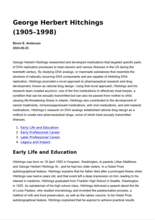Filter my results


Johannes Holtfreter made important discoveries about the properties of the organizer discovered by Hans Spemann. Although he spent much time away…
Organizers, EmbryonicBiographyFrogs
George Herbert Hitchings researched and developed medications that targeted specific parts of DNA replication processes to treat cancers and various…
Nucleoside analogDNA ReplicationDrug DevelopmentAcyclovirPharmacology
In the 2013 legal case Association for Molecular Pathology v. Myriad Genetics, Inc., hereafter AMP v. Myriad, the United States Supreme Court held in…
PatentNucleotide sequenceBreast CancerBRCA1 geneBRCA2 gene
Jacques Loeb developed procedures to make embryos from unfertilized sea urchin eggs in 1899. Loeb called the procedures "artificial parthenogenesis…
ParthenogenesisExperimentsSea Urchins
Nerve growth factor (NGF) is a signaling protein and growth factor implicated in a wide range of development and maintenance functions. NGF was…
Nerve Growth FactorChicks
National Geographic's documentary In the Womb: Identical Twins focuses on the prenatal development of human identical twins. Director Lorne Townend…
LiteratureTwinsDocumentary filmsTestosteroneMethylation
Wilhelm Roux was a nineteenth-century experimental embryologist who was best known for pioneering Entwicklungsmechanik, or developmental mechanics.…
PeopleRoux, Wilhelm, 1850-1924Biography
Shoukhrat Mitalipov, Masahito Tachibana, and their team of researchers replaced the mitochondrial genes of primate embryonic stem cells via spindle…
monkeysrhesus macaqueSendai virusEmbryonic Stem CellsMitochondrial Diseases
In 1830, a dispute erupted in the halls of lÕAcad mie des Sciences in Paris between the two most prominent anatomists of the nineteenth century.…
EssayAnimals--ClassificationCuvier, Georges, baron, 1769-1832AnatomyBiological Evolution
When cells-but not DNA-from two or more genetically distinct individuals combine to form a new individual, the result is called a chimera. Though…
ContextChimerismEmbryosEmbryonic Stem CellsMosaicism